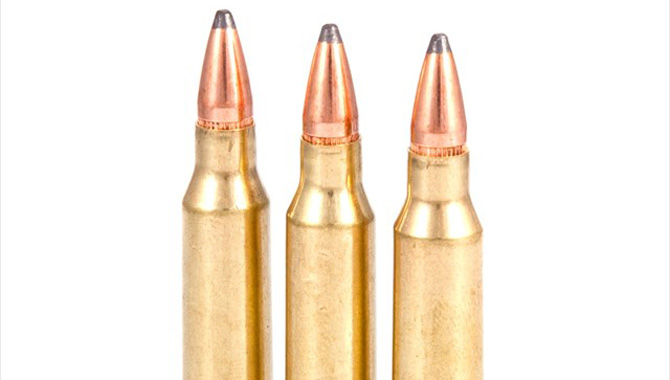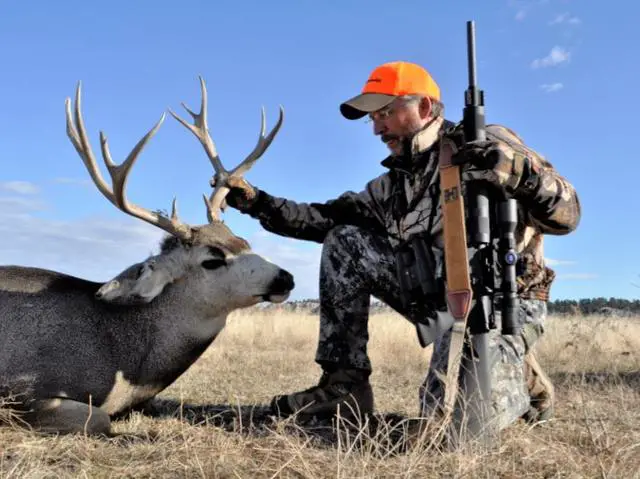“Ethical Considerations: Hunting Whitetail Deer with a 5.56 or .223 Caliber Rifle – Exploring the Controversy”
Ethical Considerations of Using a 5.56 or.223 Caliber Rifle for Whitetail Deer Hunting

1. Shot Placement and Quick Kill
One important ethical consideration when using a 5.56 or.223 caliber rifle for whitetail deer hunting is the need for expert shot placement. The smaller caliber requires precise aim to ensure a quick and humane kill. It is crucial to hit the middle of the heart or lungs, as clipping the vitals may still result in the death of the deer but not as quickly. A liver shot or gutshot can lead to prolonged suffering for the animal and make tracking it more challenging. Therefore, hunters must prioritize accuracy and ensure they have the necessary skills to make clean kills.
2. Risk of Predation
Another ethical concern with using a smaller caliber rifle is the increased risk of predation on wounded deer. If a deer is not killed quickly and efficiently, there is a higher chance that predators like coyotes may reach it before hunters do. This not only results in additional suffering for the animal but also goes against responsible hunting practices that aim to minimize unnecessary harm.
3. Range Limitations
The 5.56 or.223 caliber rifles are known for their shorter range capabilities compared to larger calibers like 30-06 or 308 WIN. While they can still be effective within their effective range, hunters must be aware of these limitations and adjust their hunting strategies accordingly. It is essential to be within comfortable shooting distances to ensure accurate shots and avoid wounding without immediate kills.
In conclusion, using a 5.56 or.223 caliber rifle for whitetail deer hunting raises ethical considerations related to shot placement, quick kills, risk of predation, and range limitations. Hunters must prioritize expert marksmanship, aiming for vital organs to ensure humane kills. Additionally, they should be mindful of the increased risk of predation on wounded deer and adjust their hunting strategies accordingly. Understanding the limitations of the caliber and staying within comfortable shooting distances is crucial for ethical hunting practices.
Expert Shot Placement and the Ethics of Using a 5.56 or.223 Caliber Rifle for Deer Hunting

Using a 5.56 or.223 caliber rifle for deer hunting requires expert shot placement to ensure a quick and ethical kill. It is crucial to aim for the middle of the heart or lungs, as clipping the vitals may still kill the deer but not as quickly. A liver shot or gutshot can result in the animal dying several hours later, leading to a long tracking process. Additionally, there is a risk of coyotes getting to the wounded deer before the hunter does.
For new hunters, a good low recoil caliber option is the 30-30. While accurate and with decent power, it is important to note that it is a shorter range weapon. With proper shot placement, such as hitting the lung area, it can effectively take down a deer at around 70 yards.
Some hunters argue that even smaller calibers like.223 REM can be used as their primary deer rifle. They believe that if a.243 WIN can work effectively, why not a.223 REM? However, personal preference often plays a role in choosing larger calibers like 30-06 and 308 WIN for comfort and familiarity.
While some individuals have successfully harvested deer using smaller calibers like.22 Hornet or even.223 REM rifles, it is essential to check local hunting regulations regarding minimum caliber requirements before making any decisions. In certain states, using calibers below a certain threshold may be illegal for harvesting deer.
Ultimately, successful deer hunting with smaller calibers depends on factors such as marksmanship skills and adherence to ethical hunting practices. Expert shot placement and understanding state hunting laws are crucial considerations when deciding whether to use a 5.56 or.223 caliber rifle for deer hunting.
The Effectiveness and Ethics of Using a 5.56 or.223 Caliber Rifle for Harvesting Whitetail Deer

Shot Placement and Caliber Considerations
When using smaller calibers such as the 5.56 or.223, expert shot placement is crucial for quickly and ethically killing a whitetail deer. It is essential to aim for the middle of the heart or lungs to ensure a clean kill. Clipping the vitals may still result in the deer’s death, but it will not be as quick. A liver shot or gutshot can be fatal, but it may take several hours for the animal to succumb, leading to a long tracking process. Delaying the kill can also attract predators like coyotes, who may reach the deer before the hunter does.
The 30-30 Caliber as a Low Recoil Option
For new hunters seeking a low recoil caliber, the 30-30 is often recommended. While it has decent power and accuracy, it is considered a shorter range weapon compared to other calibers. Many hunters have successfully taken down deer with this caliber at close distances, typically around 70 yards or less. With proper shot placement through the lungs, deer can be effectively killed with this caliber.
While some experienced hunters have reported success using.223 REM for deer hunting, there are factors to consider before opting for this caliber. It is important to check local laws regarding caliber regulations for harvesting deer, as some states may have restrictions on using smaller calibers. Additionally, shot placement and marksmanship skills play a crucial role in ensuring a clean and ethical kill. Wind direction and scent control are also important factors to consider when hunting deer.
Overall, while using a 5.56 or.223 caliber rifle for whitetail deer hunting can be effective in the hands of an experienced shooter with proper shot placement, it is essential to consider local regulations, personal comfort with the caliber, and other factors that contribute to a successful and ethical hunt.
Exploring the Viability and Ethics of Hunting Whitetail Deer with a 5.56 or.223 Caliber Rifle

Whitetail deer hunting is a popular sport, and hunters often debate the suitability of different calibers for taking down these animals effectively. One perspective shared in the content is that while smaller calibers like 5.56 or.223 can be used to kill a deer, expert shot placement is crucial. It is recommended to aim for the heart or lungs to ensure a quick and humane kill. Clipping vital organs may still result in the animal’s death, but it may not be as swift. A liver or gut shot can lead to a prolonged tracking process, potentially attracting scavengers like coyotes.
The content also suggests that new hunters could consider using a low recoil caliber like the 30-30 for their first deer hunting experiences. This caliber offers decent power but has a shorter range compared to other options. The author shares their personal experience of successfully killing their first deer at 70 yards with a 30-30 rifle.
In response to the question of whether a.223 caliber rifle can be used for deer hunting, different opinions are presented. Some argue that with accurate shot placement, the.223 REM can effectively kill deer because they are not particularly hard to kill. However, others prefer larger calibers like 30-06 or.308 WIN because they feel more comfortable using them and have other projects related to those calibers.
The viability of using a.223 caliber rifle for deer hunting depends on factors such as marksmanship skills and adherence to state hunting regulations regarding caliber restrictions. Some individuals share personal anecdotes of successfully harvesting deer with.22 Hornet or.223 rifles, emphasizing the importance of accurate shooting and scent control.
Overall, while there are differing opinions on using smaller calibers like 5.56 or.223 for deer hunting, it is essential to prioritize shot placement and adhere to legal requirements to ensure a humane and ethical hunting experience.
Balancing Shot Placement and Ethics: Can a 5.56 or.223 Caliber Rifle be Used Responsibly for Whitetail Deer Hunting?

Balancing Shot Placement and Ethics: Can a 5.56 or.223 Caliber Rifle be Used Responsibly for Whitetail Deer Hunting?
When it comes to hunting whitetail deer, shot placement is crucial for a quick and humane kill. While smaller calibers like the 5.56 or.223 can certainly be used, expert shot placement becomes even more important. It is essential to aim for the middle of the heart or lungs to ensure a clean and efficient kill. Merely clipping the vitals may still result in the deer’s death, but not as quickly. A liver shot or gutshot can be fatal but will lead to a longer tracking process, potentially giving coyotes an opportunity to scavenge before you retrieve your kill.
For new hunters or those who prefer lower recoil calibers, the 30-30 is often recommended. It offers decent power and accuracy but is considered a shorter-range weapon. Many hunters have successfully taken down their first deer with a 30-30 at around 70 yards, achieving a perfect lung shot that resulted in a short run of about 40 yards.
Some experienced hunters argue that caliber size does not necessarily determine how effectively it can take down a deer. They believe that if a.243 Winchester works, why not a.223 Remington? Deer are not particularly difficult to kill, and with proper shot placement, even smaller calibers can get the job done efficiently.
However, personal preference plays a significant role in choosing the right caliber for hunting deer. Some hunters prefer larger calibers like the 30-06 or 308 Win because they feel more comfortable with them. Additionally, certain projects or commitments may take precedence during hunting season, making it challenging to focus on using different calibers like the.223 Remington.
It is important to note that different states may have regulations regarding minimum caliber requirements for harvesting deer. Before using a 5.56 or.223 caliber rifle for deer hunting, it is crucial to check your local laws to ensure compliance.
In conclusion, while a 5.56 or.223 caliber rifle can be used responsibly for whitetail deer hunting, it requires expert shot placement and careful consideration of ethical practices. Ultimately, the choice of caliber depends on personal preference and adherence to local hunting regulations.
Understanding the Debate: Is it Ethical to Hunt Whitetail Deer with a 5.56 or.223 Caliber Rifle?
The Importance of Shot Placement
When considering hunting whitetail deer with a smaller caliber rifle such as a 5.56 or.223, expert shot placement becomes crucial. It is necessary to aim for the middle of the heart or lungs to ensure a quick and humane kill. Merely clipping the vitals may still result in the deer’s death, but it will not be instantaneous. A liver or gutshot can lead to the animal suffering for several hours before succumbing, making tracking and retrieval a lengthy process. Additionally, delayed kills may attract scavengers like coyotes, who may reach the deer before hunters do.
The Need for Low Recoil Calibers for New Hunters
For new hunters, a good option is a low recoil caliber like the 30-30. This cartridge offers accuracy and decent power but has a shorter effective range compared to other calibers. The author shares their personal experience of successfully killing their first deer at 70 yards with a 30-30 rifle using a perfect lung shot that resulted in only a 40-yard run by the animal. However, it is essential to emphasize that even with smaller calibers, expert shot placement is still necessary for ethical hunting.
The Viability of Using.223 REM for Whitetail Deer Hunting
The author acknowledges that while they personally do not use.223 REM rifles for whitetail deer hunting, they know fellow hunters who consider it their primary choice. They argue that if calibers like.243 WIN can effectively kill deer, there is no reason why.223 REM cannot achieve similar results. The author explains their preference for larger calibers like 30-06 and 308 WIN due to personal comfort and the need to generate content for their writing projects. However, they express willingness to recommend real experts on using.223 REM for deer hunting.
Personal Experiences and Considerations
The discussion includes anecdotes from different individuals regarding their experiences hunting deer with smaller calibers. One person shares how their father successfully harvested deer using a 22 Hornet rifle, highlighting the importance of marksmanship skills. Another individual recounts bagging an eight-point buck with a Bushmaster XM15E2S (.223 caliber) rifle, emphasizing the significance of shot placement and scent control. They also stress the need to comply with state hunting laws regarding caliber regulations.
In conclusion, the debate surrounding hunting whitetail deer with a 5.56 or.223 caliber rifle revolves around factors such as shot placement, recoil, personal preference, and adherence to local hunting regulations. While some hunters find success with smaller calibers, others prefer larger ones for various reasons. Ultimately, ethical hunting practices and responsible decision-making should guide hunters in choosing the appropriate caliber for harvesting whitetail deer.
In conclusion, the ethical use of a 5.56 or.223 caliber rifle for hunting whitetail deer is subjective and depends on multiple factors. While these calibers may lack the ideal stopping power, proper shot placement can still result in ethical kills. However, hunters must prioritize accuracy, proficiency, and ensuring a quick and humane kill to minimize suffering. Ultimately, responsible decision-making should guide the choice of firearm for hunting whitetail deer.
https://www.youtube.com/watch?v=_5QV5Hl0wR8&pp=ygVLQ291bGQgYSA1LjU2IG9yIC4yMjMgY2FsaWJlciByaWZsZSBiZSBldGhpY2FsbHkgdXNlZCB0byBodW50IHdoaXRldGFpbCBkZWVy











































